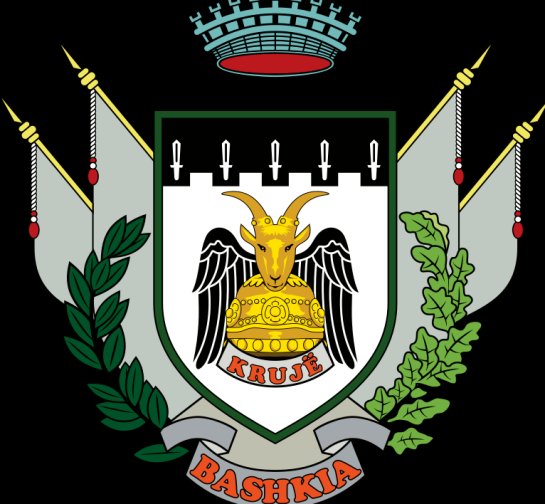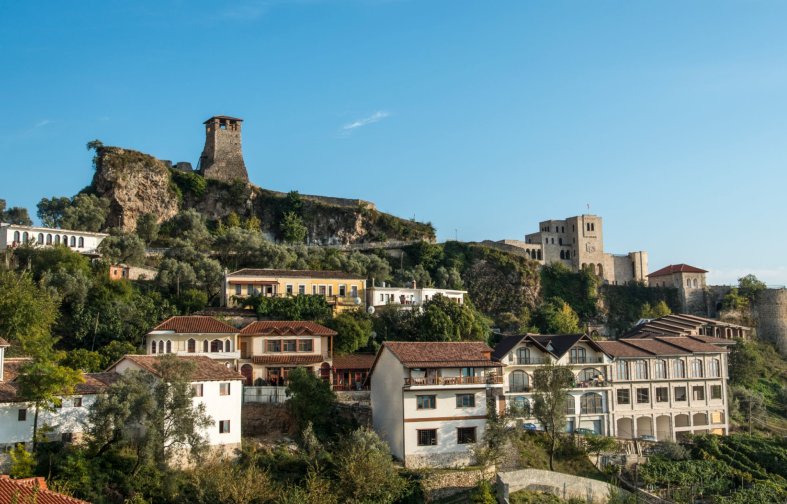

KRUJAThe Ottomans took control of the town after the fourth siege in 1478, and incorporated it in their territories. A 1906 local revolt against the Ottoman Empire was followed by the 1912 Declaration of Independence of Albania. In the mid-1910s Kruja was one of the battlefields of the conflict between the short-lived Republic of Central Albania, founded by Essad Toptani, and the Principality of Albania. In 1914 Toptani managed to seize the town but during the same year it was reincorporated by Prênk Bibë Doda in the Principality of Albania. During World War II it was the center of the activities of resistance leader Abaz Kupi.The museums of Kruja include the Skanderbeg Museum, located in the environs of the Kruja Castle, and the national ethnographic museum. The name of the city is related to the Albanian word kroi, krua, meaning "fountain". The city was attested for the first time as Kroai (in medieval Greek Κροαί) in Byzantine documents of the early 7th century. In medieval Latin it was known as Croia, Croya and Croarum. During the Ottoman era it was also known as Ak Hisar or Akçahisar from the Turkish words ak (white) and hisar (castle).
Ancient
Medieval Until 1432, the subaşi (governor) of Kruja had been Zagan Bey, then Hizir Bey, and later during 1437—1438 Skanderbeg was its governor. In November 1438 Hizir Bey was again appointed as subaşi of Kruja until he was replaced in April 1440 by Umur Bey. On 28 November 1443 Skanderbeg gained control over Kruja by deceiving its subaşi with forged sultan's letter. In 1444 Skanderbeg incorporated it in the League of Lezhë, the confederation of the Albanian principalities. |
 |
 |
From 1450 until 1477 Kruja was defended successfully by the Albanian troops four times against the Ottoman army, which eventually captured it in 1478 during the fourth Siege of the city. During the first siege of Kruja in 1450, the 1,500 to 2,000 soldiers of the League of Lezhë under Vrana Konti and Skanderbeg defeated an Ottoman force of about 100,000 men led by Sultan Murad II, who had tried to bribe Konti to surrender the castle of the town. In the following decade Kruja was first besieged in 1466 and then in 1467 unsuccessfully by Ballaban Pasha and Sultan Mehmed II, whose total troops were about 150,000. After Skanderbeg's death in 1468, the city's garrison was supplemented by troops of the Republic of Venice. In 1476 the town was once more besieged by a ten-thousand-man army under Gedik Ahmed Pasha; however, the local garrison led by proveditor Pietro Vetturi fended off the Ottoman besiegers, who retreated after the arrival of reinforcements under Francesco Contarini and Nikollë Dukagjini. The city was eventually conquered by the Ottomans in 1478 after being besieged for over a year. This success was viewed by the Ottomans as a good omen that the siege of Shkodra would also be successful.
Modern After prolonged confrontations the Ottoman officials offered to begin negotiations with the rebels. On 20 September 1906 the leaders of Kruja and the Ottoman diplomats met at the Tallajbe quarter of Kruja to discuss the administrative status of the town, however, the Ottoman army under Şemsi Pasha ambushed the rebel leaders. During the battle that followed, which became known in history after the Tallajbe district, about 30 people died including uninvolved civilians. Throughout the Albanian Revolt of 1912, that led to the creation of the Albanian Vilayet and later in the Declaration of Independence of Albania Kruja, which was captured on 14 August, was one of the major anti-Ottoman centers. In 1914 Essad Toptani, a member of the notable Toptani family of the region and officer of the Ottoman army, captured the town and incorporated it in the Republic of Central Albania making it a center of his movement, but in June of the same year it was reincorporated by Prênk Bibë Doda in the Principality of Albania. On 20 December 1914 the local anti-Essadists, led by Abdi Toptani and Mehmet Gjinali, formed the Union of Kruja, which quickly extended its authority in central Albania. Following the Italian invasion of Albania the country became a protectorate of the Kingdom of Italy. Mustafa Merlika-Kruja, a native of Kruja, who became the Prime Minister of the new regime ordered the formation of a 300-man gendarmerie force to defend the town against resistance groups. However, soon afterward, resistance leader Abaz Kupi, another native of the town, created one of the first permanent resistance forces of Albania in Kruja and gradually took control of the region. In 1943 at the assembly of Tapizë Balli Kombëtar proposed to the LNÇ the creation of provisional resistance government, with Kruja as the capital city, but this proposal was rejected by the LNÇ leaders. In the end of November 1944, the last German troops stationed in the area were defeated and LNÇ battalions entered the town. |
 |
 |
SightsThe fortress of Kruja is a historical sanctuary for the Albanian nation. The Skanderbeg Museum within the fortress wall, where the struggle of the Albanians under Skanderbeg and his League of Lezha, was designed by the architect Pranvera Hoxha, the daughter of Enver Hoxha, and is designed to give the impression of a medieval fortress. Within the fortress walls there is also a small doll's house of the Bektashi, an ethnographic museum and a Turkish bath. In the lower part of the fortress there are numerous small houses where families still live. At the foot of the castle hill there is a restored bazaar road, whose buildings date back to the 19th century and reflect the typical architecture of the mountainous area. For tourists visiting the sights of the city, there are several hotels, cafes, bars and numerous souvenir stands as hardly in Albania. Most visitors arrive for a few hours from Tirana or Durrës or make a short stop in transit. City tours are offered. The presumed burial place of Sari Saltik on the mountain above the city also offers a wide view over the region. One mountain range further east is the Qafë Shtama National Park. At the foot of the mountain not far from Fushë-Kruja are the ruins of the Illyrian site of Zgërdhesh.
|
 |
 |